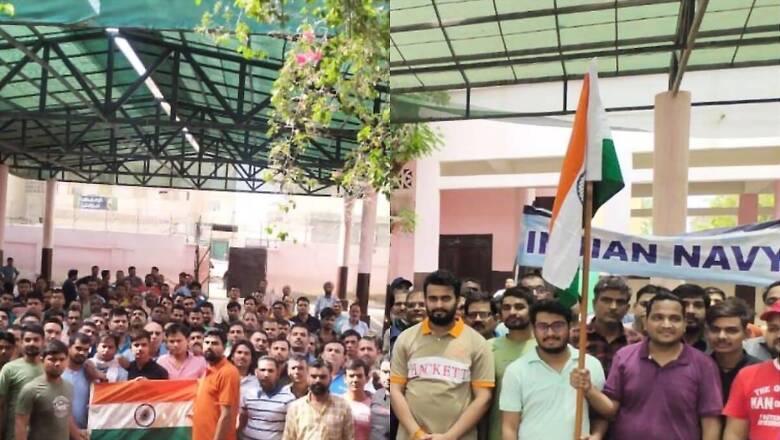
views
India on Monday launched ‘Operation Kaveri’ to bring back stranded citizens amid escalating violence due to clashes between the army and paramilitary forces in the Sudanese capital Khartoum.
According to S Jaishankar, the External Affairs Minister, the evacuation process of Indian citizens from Sudan is currently in progress, with approximately 500 nationals having already arrived at strategic Port Sudan.
Operation Kaveri gets underway to bring back our citizens stranded in Sudan. About 500 Indians have reached Port Sudan. More on their way.
Our ships and aircraft are set to bring them back home.
Committed to assist all our bretheren in Sudan. pic.twitter.com/8EOoDfhlbZ
— Dr. S. Jaishankar (@DrSJaishankar) April 24, 2023
The announcement came a day after the Ministry of External Affairs (MEA) announced it has stationed two IAF C-130J transport aircraft on standby in Jeddah, Saudi Arabia, and the INS Sumedha naval ship at Port Sudan as part of its emergency measures to evacuate stranded Indian citizens.
However, the statement noted the security situation in Sudan remains volatile, with reports of fierce fighting in various locations in Khartoum. The movement of Indian citizens from Sudan would depend on the ground security situation, which is being closely monitored. India is coordinating with several partner countries, including Saudi Arabia, the UAE, Egypt, and the US, to ensure the safe evacuation of its citizens. The MEA and the Indian embassy in Sudan are in regular contact with the UN and Sudanese authorities, it said.
The government has been prioritising the safety of more than 3,000 Indian citizens currently spread across Sudan, as announced on Friday. Prime Minister Narendra Modi held a high-level meeting on the same day and instructed officials to prepare contingency plans for the evacuation of Indians from Sudan.
At least 427 people have been killed and more than 3,700 wounded in the fighting, according to UN agencies.
‘Operation Kaveri’ joins a long list of rescue missions undertaken by the Indian government to evacuate its citizens from regions of conflict and crisis situations. Here’s a look:
Operation Ganga 2022
India launched Operation Ganga on February 26, 2022, following Russia’s military aggression against Ukraine and brought back nearly 20,000 of its nationals in a massive rescue mission. To facilitate the evacuation process, a massive operation was undertaken, involving the deployment of Indian Air Force C-17 aircraft and embassy officials rushing to railway stations in Kyiv. The Ministry of External Affairs (MEA) also set up a control room, in addition to control centres operated by Indian embassies, which functioned round-the-clock. After the operation concluded in March, officials reported that the MEA control room had attended to 12,582 calls and 9,131 emails according to data by March 7.
Operation Devi Shakti (2021)
Operation Devi Shakti was carried out by the Indian Armed Forces to evacuate hundreds of Indians from Afghanistan in 2021 after the Taliban and allied militant groups seized control of the country and the capital city of Kabul, leaving many Indians stranded. The operation was initiated after the collapse of the Islamic Republic of Afghanistan and the withdrawal of most U.S. troops from the country, which occurred on 1 May 2021.
Operation Samudra Setu (2021)
The Indian government launched “Operation Samudra Setu” to repatriate Indians stranded overseas due to the Covid-19 pandemic. This naval operation involved four Indian naval ships – Jalashwa (Landing Platform Dock), Airavat, Shardul, and Magar (Landing Ship Tanks) – and brought back over 3,000 Indian citizens to their homeland. The operation lasted for over 55 days and covered more than 23,000 km by sea.
Vande Bharat 2020
Launched on May 7, 2020, Operation Vande Bharat aimed to repatriate Indians stranded in various countries due to the Covid-19 pandemic. In an operation that started that continued through 2021, India successfully evacuated over 1.8 million citizens in more than 15 phases. In addition to flights, naval ships were used to bring back 3,987 Indians, while 5,02,151 were repatriated through land border crossings, as per a report by Moneycontrol. The first two Air India flights of the mission transported 363 nationals from the UAE to Kerala on 7 May 2020. Over time, the mission expanded, with almost 30,000 flights operated as part of the Vande Bharat Mission until 2 August 2021, as per data from the civil aviation ministry.
Operation Raahat 2015
During the conflict between the Yemeni government and Houthi rebels in April 2015, India initiated the evacuation of its citizens. Despite ongoing aerial bombardment, 6,688 people were evacuated from Yemen, including 4,741 Indians and 1,947 foreign nationals through air and sea routes. Foreign citizens from the United States, Britain, France, and Pakistan were also rescued. The then Minister of State for External Affairs, VK Singh, led the operation, shuttling between Sana’a and Djibouti. Despite the challenges, the operation successfully repatriated stranded individuals.
Operation Maitri 2015
In April 2015, a massive earthquake of magnitude 7.8 hit Nepal, resulting in close to 9,000 deaths and over 21,000 injuries. India immediately launched ‘Operation Maitri’ within 15 minutes of the tragedy to aid its neighbour with massive relief and rescue efforts.
The Indian Air Force and civilian aircraft were deployed to evacuate around 5,000 Indians from Nepal along with foreign nationals from countries such as the US, UK, Russia, and Germany. The Indian Armed Forces mobilized their Il-76, C-130J Hercules, and C-17 Globemaster transport aircraft and Mi-17 helicopters to airlift those stranded in Nepal. The joint relief and rescue operation by the Indian government and Indian Armed Forces successfully brought back over 5,000 Indians and 170 foreign nationals to safety.
Operation Safe Homecoming 2011
In 2011, a civil war erupted in Libya as rebel forces aimed to overthrow the country’s dictator, Muammar Gaddafi. The protests spread across the country, and by mid-February, the situation had become volatile. With thousands of Indians working in Libya, the Indian government launched Operation Safe Homecoming on 26 February, aiming to evacuate its citizens.
Over 15,400 Indians were successfully rescued under this operation, which utilized both air and sea transport. The Indian government arranged for nine special flights to bring back Indian nationals from Libya, as well as from neighboring nations such as Egypt and Malta. The Indian Navy also assisted in the evacuation effort by using sea routes for some evacuations.
Operation Sukoon 2006
In 2006, a military conflict broke out between Israel and the Lebanese militant group Hezbollah, known as the Lebanon War. During the war, around 10,000 Indians lived in Lebanon, with 2,000 in the conflict zone. To rescue these people, the Indian government launched Operation Sukoon.
Operation Sukoon, also known as the Beirut Sealift, is recognised as the largest-ever evacuation operation after the Dunkirk evacuation in France during the second world war. From July 19 to August 1, 2006, over 2,000 nationals from India, Sri Lanka, and Nepal were evacuated under the operation. The mission successfully rescued 1,764 Indians, 112 Sri Lankans, 64 Nepalese, and seven Nepalese nationals with Indian spouses.
The airlift from Kuwait
The Indian government’s airlift of its citizens from Kuwait in 1990 remains one of the largest rescue operations ever undertaken. The mission was launched after Kuwait was invaded by Iraqi forces, and Air India and other aircraft were deployed to rescue 1,75,000 people between August and October of that year. This massive evacuation effort made history, with Air India’s feat of airlifting the largest number of people in a civilian plane earning it a spot in the Guinness Book of World Records.
(With inputs from agencies)
Read all the Latest India News here



















Comments
0 comment